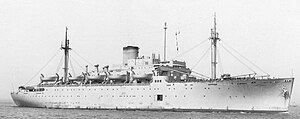USNSHenry Gibbins
 USNSHenry Gibbins(T-AP-183), c. 1952
| |
| History | |
|---|---|
| Name | USNSHenry Gibbins(T-AP-183) |
| Namesake | US ArmyGeneralHenry Gibbins |
| Builder | Ingalls Shipbuilding |
| Laid down | 23 August 1941 |
| Launched | 11 November 1942 |
| Sponsored by | Mrs H. I. Ingalls, Jr. |
| Acquired | (By the Army): 27 February 1943 |
| In service | |
| Renamed | Henry Gibbins(1943),Empire State IV(1959),Bay State(1973) |
| Identification |
|
| Fate | Scrapped in 1983 after fire |
| General characteristics | |
| Displacement | 10,556 tons |
| Length | 489 ft |
| Beam | 70 ft |
| Draft | 26 ft |
| Propulsion | Turbine engines, single shaft, 8,500shp |
| Speed | 16.5knots |
| Troops | 1,976 |
USNSHenry Gibbins(T-AP-183)was atroop transportthat served with theUnited StatesMilitary Sea Transportation Service(MSTS) during the 1950s. Prior to her MSTS service, she served asUS ArmytransportUSATHenry GibbinsduringWorld War II.She later served with theNew York Maritime AcademyasTSEmpire State IVand with theMassachusetts Maritime AcademyasUSTSBay State.
Henry Gibbinswas one of four ships planned for the United States Lines North Atlantic service and ordered underMaritime Commissioncontract from theIngalls Shipbuilding CompanyofPascagoula, Mississippiwith the allocated name ofAmerican Banker.Laid down on 23 August 1941; she was launched on 11 November 1942 asBiloxi.She was delivered to theArmy Transportation Service27 February 1943 asHenry Gibbinsand served the Army as a troop transport during World War II.
Refugee transport, WW-II
[edit]In accordance with PresidentFranklin D. Roosevelt's 1944 executive order authorizing 1,000 refugees to enter the United States, 982 people boarded the ship, leaving Naples, Italy, on 21 July 1944, and making the trans-Atlantic crossing.[1][2]Throughout the voyage, the Henry Gibbins was hunted by Nazi seaplanes and U-boats. The story was captured byRuth Gruber,who played an instrumental part in the mission in her book Haven: The Dramatic Story of 1000 World War II Refugees and How They Came to America. The boat arrived in New York on 3 August 1944.[3]
Infantry transport, WW-II
[edit]On 27 August 1944, theHenry Gibbinssailed as part of a convoy of up to 100 ships from New York Harbor to Cherbourg. The troops on board were part of the328th Infantry Regimentwhich was a subordinate unit of the 26th Infantry Division. The boat arrived at Cherbourg on 7 September 1944.[4]The crossing on the Henry Gibbins was depicted in the graphic novel, The English GI: World War II Graphic Memoir, the story of Bernard Sandler.[5]
Post WW-II
[edit]Following the war, theHenry Gibbinswas refitted as a "war brides ship", a baby passenger liner. Three decks of cabins, lounges, two formal staircases, a formal dining room and substantial plumbing upgrades were installed, and the Army operated her to transport American military personnel and their dependents on a route between Bremerhaven and the US East Coast until she was transferred to theU.S. Navyin 1950.[6]
Navy service
[edit]Henry Gibbinswas acquired by theU.S. Navyfrom the U.S. Army on 1 March 1950, and assigned to the Military Sea Transportation Service. During theKorean Warshe transported men and equipment fromNew York Cityto theCaribbeanandCanal Zoneports, prior to their assignment in thePacific.In 1953,Henry Gibbinsoperated on the New York toBremerhaven, Germany,andSouthampton, England,runs, making a total of 12 cruises to theseEuropeanports.
From 1954 until late 1959 the veteran transport steamed from New York to the Caribbean over 75 times, sailed to theMediterraneanon 3 occasions and crossed theAtlantictoNorthern Europe8 times. During this timeHenry Gibbinsshuttled thousands of troops and tons of supplies between theUnited Statesand her foreign bases.
Henry Gibbinswas transferred from MSTS to theUnited States Maritime Administration2 December 1959, atFort Schuyler,New York, for service with the New York Maritime College. The college named her TSEmpire State IVand she retained that name until being transferred to theMassachusetts Maritime Academyin 1973. At that time she was renamed USTSBay State.
During the winter of 1976–77, one of the coldest in fifty years, theBay Statesuffered serious ice damage to her hull at her berth inBuzzards Bayat the southern end of theCape Cod Canal.The hull plates were repaired and the ship continued to serve as a training vessel for two more years. In the summer of 1977 she carried cadets to Europe. In the summer of 1978 she made a training cruise to the Mediterranean.
The vessel was returned to theMaritime Administrationafter her final training cruise in 1978. Between the hull damage she had sustained in 1977, her age, and an increase in Massachusetts Maritime Academy's enrollment, she no longer suited the academy's requirements.
According to the U.S. Maritime Administration, the ship was scrapped in 1983 after suffering an engine room fire.[7]
References
[edit]- ^Bernard, Diane (May 1, 2019)."Jews fleeing the Holocaust weren't welcome in the U.S. Then FDR finally offered a refuge to some".The Washington Post.RetrievedMay 3,2019.
- ^Wecker, Menachem; Borschel-Dan, Amanda (April 29, 2014)."The woman who launched 1,000 Jewish refugees".The Times of Israel.RetrievedMay 3,2019.
- ^https:// rbhousemuseum.org/wp-content/uploads/2018/04/FortOntarioRefugeeArrivalSM.pdf[bare URL PDF]
- ^"European Center of Military History (EUCMH) 26-ID (Raw Data) SGT James Haahr".27 March 2020.
- ^THE ENGLISH GI: WORLD WAR II GRAPHIC MEMOIR OF A YORKSHIRE SCHOOLBOY’S ADVENTURES IN THE UNITED STATES AND EUROPE,2022, Jonathan Sandler
- ^Bartnett, Edmond J. "Army's transport dons luxury look: Henry Gibbins open to public inspection",New York Times.April 6, 1949. Page 31.
- ^Priolo, Gary."USNSHenry Gibbins(T-AP-183) ".NavSource Online: Service Ship Photo Archive.NavSource Naval History.Retrieved22 February2021.
Further reading
[edit]- USATHenry Gibbins- DANFS Online.
- T-AP-183Henry Gibbins,Navsource Online.
- Ruth Gruber (19 October 2010).Haven: The Dramatic Story of 1,000 World War II Refugees and How They Came to America.Open Road Media.ISBN978-1-4532-0606-5.
